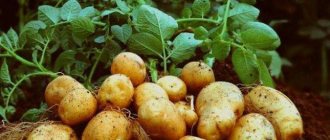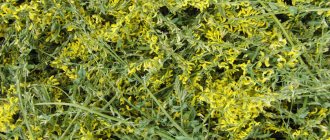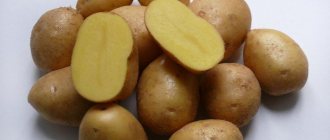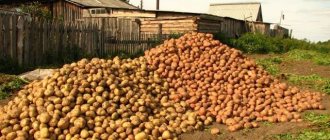About the variety name
The variety got its name due to the golden-pink color of the tubers. Apparently, the breeders who bred it are great connoisseurs of art. After all, not everyone knows that the Spanish artist, sculptor and designer Pablo Picasso in 1905–1907 painted his paintings in pink-yellow and pink-gray tones. This was the so-called pink period of his work.
Picasso got his name due to his unusual coloring.
Characteristics of the Picasso variety
Picasso is a Dutch potato variety included in the State Register of the Russian Federation in 1995. Recommended for cultivation in the Central and Central Black Earth regions. Belongs to the late type of potato, from the moment of germination to lodging of the tops - 120–140 days. Highly productive. Capable of producing 190–320 kg of potatoes per hundred square meters. The people gave him many names - Drunkard, Matryoshka, Little Red Riding Hood, Ryabukha, Lyska, Ivan da Marya.
Description of the plant
The plants grow tall and form a spreading, voluminous bush with large dark green leaves and white corollas. Potatoes bloom profusely, but rarely produce seed berries. Up to 20 fruits are usually formed in one bush. Due to the large area of foliage, the plant absorbs a lot of light. Photosynthesis enhances all processes, including the development of the root system, which intensively absorbs useful substances from the soil, accelerating the formation of fruits.
Picasso potatoes are distinguished by abundant flowering
Appearance of potato tubers
Potato tubers are round oval in shape, with small eyes, the skin is yellow with pink spots. Weight 70–120 grams. The pulp is creamy with a good taste. Starch content - 8–13%. The tubers are stored well in winter, practically without sprouting, and are transported without damage.
Picasso potato fruits have a good rich taste
Purpose of the variety
Picasso - table potatoes. Due to their low starch content, the tubers retain their integrity well during heat treatment and are suitable for preparing any dishes.
Picasso potato tubers are slightly boiled and therefore retain their shape perfectly
Reviews
Feedback from farmers about the Picasso variety is mostly positive. However, there are also negative ones - not everyone is happy with its taste.
Valery, Valuiki : “We have fallen in love with this variety for a long time. Initially, I was attracted by its interesting appearance - yellow skin with pink eyes. And then we realized that the potatoes tasted great. The yield is high, we collect about 20 tubers from one bush. The crop is unpretentious in care, but requires the application of organic and mineral fertilizers.”
Lyudmila, Oboyan : “Last year I planted several rows of these potatoes and reaped a rich harvest. I didn’t like the taste of the potatoes; they break when fried. Stored without problems, does not grow. I won’t plant any more, there are much tastier varieties.”
Olga, Glazunovka : “This is the most popular variety on our market. We grow potatoes for sale, and Picasso is the first to be bought. This is facilitated by the beautiful lemon-colored peel with pink splashes and the tasty pulp with a pronounced potato aroma. Maintenance is simple, consisting of moderate watering, weeding and adding organic matter and minerals.”
Soil requirements
The main requirements of potatoes for soil are fertility. To enrich it, fertilizers are applied during plowing in the fall and spring.
The soil for potatoes should be well fertilized
Potatoes can be planted after predecessors such as cabbage, legumes, and cereals. To maintain crop rotation - alternating crops - after harvesting, you need to plant green manure before winter. Mustard or rye, for example, perfectly enrich the soil and make it loose.
To maintain crop rotation, mustard is planted after potatoes.
Rules for planting potatoes
Potatoes are planted in different regions at different times - from April to May. The main thing is that the soil warms up to +9 degrees at a depth of 10 cm.
The method of planting potatoes is chosen based on soil and climatic conditions. There are three main methods: smooth (in holes), ridge and trench. When planting potatoes, fertilizers are added to the soil in the form of ash and humus (a handful at a time). Planting depth is 10–12 cm on light soils, 6–8 cm on heavy soils.
When planting potatoes, fertilizers are applied to the hole
Due to the extensive bushiness of plants, tubers are planted according to a 45*70 cm pattern. With frequent planting, the plants will interfere with each other’s full growth.
The variety does not require preliminary germination of tubers. 1.5–2 weeks before planting, they are taken out of storage and warmed up well in the sun, treated with a stimulant such as “Gumisol” or “Epin”, and remedies for diseases and pests (“Maxim”, “Confidor maxi” and others).
Pre-planting treatment of tubers increases their immunity
Application
In cooking
As a rule, planting Picasso potatoes is done in large sizes, since few vegetables can compare with potatoes in popularity for use in cooking. Potatoes are used to prepare soups and a variety of main courses; they are baked, fried, boiled and stewed. Picasso potatoes are ideal for any dish because they have good taste. It is worth noting that potatoes of this variety do not overcook and have a pleasant aroma.
In medicine
Picasso potatoes are also used for medicinal purposes, as they contain many useful substances. If you mash hot boiled potatoes, you can make an effective compress that will quickly help cope with cough, eczema, or improve the condition of the skin during an inflammatory reaction. In folk medicine, a raw tuber is used, which is grated and applied to a burn, fungal or erysipelas on the skin. Thanks to this lotion, you can soothe the skin and the wound will heal faster.
Thanks to the fiber contained in Picasso potatoes, it is possible to improve the patient’s condition with ulcers or gastritis. If you have a metabolic disorder, it is also recommended to eat potatoes, which neutralize the effects of acids. Potato dishes are recommended for people with signs of arthritis, gout and kidney pathologies.
When losing weight
This plant is used for weight loss, despite the fact that Picasso potatoes contain many calories. This variety of vegetables is included in various diets for weight loss and fasting days. By eating Picasso potatoes with certain foods, a person can get rid of several extra pounds. The potato diet can also help people who want to not only lose weight, but maintain an optimal body weight.
At home
You can also use Picasso potatoes, characteristics, photos of which are presented in the article above, for domestic purposes. Raw potatoes can easily remove rust from kitchen utensils and metal objects. If you have silverware or smooth leather shoes, use potatoes as a polish.
In cosmetology
Picasso potatoes are widely used in cosmetology due to the starch they contain. This substance helps to quickly wash your hair, just sprinkle it with potato starch and rub it. Potatoes of this variety will also help with calluses and rough skin on the legs. To do this, you will need to apply raw potato pulp to the sole. Potatoes are also useful for swelling and dark circles under the eyes.
Plant care
Picasso is undemanding to soil and climatic conditions. It withstands unfavorable weather, excessive moisture in the soil and air or its absence. Its care requirements are modest, so even a novice gardener can grow this variety.
If there is no precipitation, you need to water the potatoes once every 7-10 days. After each watering, to ensure air access to the roots, the soil is loosened.
You need to loosen the soil after each watering
The first weeding, combined with hilling, is carried out when the seedlings rise 6-8 cm above the ground. Subsequent ones - every 2 weeks.
Potatoes need to be hilled every two weeks.
Fertilizers for potatoes are very important. They affect the taste characteristics of tubers. The plants are fed at least three times during the entire growing season. The most popular among gardeners is humus and ash, which contain all the substances necessary for potatoes. They are applied at the roots of plants, in a diluted state, without touching the foliage.
Wood ash contains nutrients essential for potatoes
Nuances of agricultural technology
As I said above, Picasso does not require any special care - the variety is really unpretentious; in order for it to produce an excellent harvest, it is enough to follow the following rules:
- Picasso needs regular weeding and loosening of the soil - this way the roots can receive much more oxygen and moisture, which will affect both the quantity and quality of the harvest. But there is an important nuance here - these procedures can only be started when the seedlings have strengthened to at least 7-8 centimeters, otherwise the risk of damaging weak roots is too great.
- Surprisingly, the variety requires almost no watering, especially when it comes to regions where it rains relatively often. Picasso makes good use of rainwater; additional watering should be introduced only if a particular period of time is very hot and dry - in this case, once every ten days or two weeks will be enough.
- It wouldn't hurt to add fertilizer - Picasso loves it and takes it well. The ideal time for this occurs three times a season - immediately after germination, immediately before flowering and during it. You should not fertilize Picasso after flowering - this is a common mistake and can harm the fruit.
- The variety is relatively resistant to diseases that often affect potatoes. The Colorado potato beetle is not at all scary to him. But late blight can significantly damage your nerves and your harvest, so periodically it is better to carry out preventive treatment of the bushes.
Resistance to diseases and pests
Potatoes have good resistance to cancer and golden nematode, average resistance to leaf curl and scab. But the variety is affected by late blight. To protect against it, fungicides - chemicals - are used by spraying. During humid periods, wood ash is used to prevent late blight. Damaged leaves must be destroyed.
The main protection of potatoes is from late blight
Of the pests, Picasso should be wary of the Colorado potato beetle. Large green potato bushes attract him. To combat, various chemicals are used (they irrigate plants) and mechanical collection of larvae and beetles. This method is by far the most effective and environmentally friendly.
The main pest for Picasso potatoes is the Colorado potato beetle.
Features of growing potatoes in the southern regions
Picasso can be grown in any region of the country. It consistently produces crops even in unfavorable weather conditions. But in different volumes. It is especially difficult to grow potatoes in the southern regions. Summer heat hinders the development of tubers. In May-June it slows down and sometimes stops altogether. Therefore, potatoes here often degenerate.
Gardeners are constantly experimenting with planting to find the best way. For example, to beat the heat, potatoes are planted in late June - early July, depending on the weather. Here, a long warm period makes it possible to harvest Picasso in late autumn.
And an experiment was also carried out in the methods of planting the variety. In one area they planted potatoes with sprouted tubers, with good sprouts. On the other, the planted tubers were not germinated, but only well heated in the sun for a week and a half. It was found that the heated tubers sprouted later than the germinated ones, but quickly increased their green mass. The ripening of tubers occurred simultaneously in two areas. No difference in yield was detected.
Harvesting
The Picasso potato variety received reviews from many gardeners and summer residents, and all thanks to its beautiful appearance and good keeping quality. To preserve the harvest until the new season, you need to properly harvest it and prepare it for storage. The storage also requires preparation, but first things first.
Picasso is a representative of late-ripening varieties, so you should start harvesting no earlier than 120 days from planting. About a week before this event, it is advisable to remove the tops so that the tubers become stronger and can dry out faster. In private gardens, potatoes are dug out of the ground, usually with a pitchfork or shovel.
Dried potatoes are carefully sorted, sorted by size and transported to a shaded place. It should stay there for some time so that excess moisture evaporates from the surface of the skin. This will prevent the crop from rotting in the basement and cellar.
Before storing them in storage, you should once again inspect all the tubers for damage. Rotten, cut and damaged specimens are immediately disposed of. A high-quality part of the harvest is stored in a cellar or basement in a special container. To do this, you can use boxes with holes, nylon nets or bags made of natural materials.
Having planted potatoes in early May, tuber harvesting begins in mid-September. Dig only in sunny weather, stopping watering, fertilizers, and chemical treatments in advance.
Digging up potatoes in sunny weather










